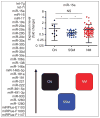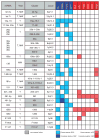Histology-specific microRNA alterations in melanoma
- PMID: 22551973
- PMCID: PMC3648670
- DOI: 10.1038/jid.2011.451
Histology-specific microRNA alterations in melanoma
Abstract
We examined the microRNA signature that distinguishes the most common melanoma histological subtypes, superficial spreading melanoma (SSM) and nodular melanoma (NM). We also investigated the mechanisms underlying the differential expression of histology-specific microRNAs. MicroRNA array performed on a training cohort of 82 primary melanoma tumors (26 SSM, 56 NM), and nine congenital nevi (CN) revealed 134 microRNAs differentially expressed between SSM and NM (P<0.05). Out of 134 microRNAs, 126 remained significant after controlling for thickness and 31 were expressed at a lower level in SSM compared with both NM and CN. For seven microRNAs (let-7g, miR-15a, miR-16, miR-138, miR-181a, miR-191, and miR-933), the downregulation was associated with selective genomic loss in SSM cell lines and primary tumors, but not in NM cell lines and primary tumors. The lower expression level of six out of seven microRNAs in SSM compared with NM was confirmed by real-time PCR on a subset of cases in the training cohort and validated in an independent cohort of 97 melanoma cases (38 SSM, 59 NM). Our data support a molecular classification in which SSM and NM are two molecularly distinct phenotypes. Therapeutic strategies that take into account subtype-specific alterations might improve the outcome of melanoma patients.
Conflict of interest statement
The authors declare no conflict of interest.
Figures





Similar articles
-
Integrative genomics identifies molecular alterations that challenge the linear model of melanoma progression.Cancer Res. 2011 Apr 1;71(7):2561-71. doi: 10.1158/0008-5472.CAN-10-2958. Epub 2011 Feb 22. Cancer Res. 2011. PMID: 21343389 Free PMC article.
-
Defining the Prognostic Role of MicroRNAs in Cutaneous Melanoma.J Invest Dermatol. 2020 Nov;140(11):2260-2267. doi: 10.1016/j.jid.2020.03.949. Epub 2020 Apr 8. J Invest Dermatol. 2020. PMID: 32275975
-
Multivariate analysis of prognostic factors in patients with nodular melanoma.J Cancer Res Clin Oncol. 2021 Sep;147(9):2759-2764. doi: 10.1007/s00432-021-03562-1. Epub 2021 Feb 25. J Cancer Res Clin Oncol. 2021. PMID: 33630139 Free PMC article.
-
MicroRNA-15b represents an independent prognostic parameter and is correlated with tumor cell proliferation and apoptosis in malignant melanoma.Int J Cancer. 2010 Jun 1;126(11):2553-62. doi: 10.1002/ijc.24960. Int J Cancer. 2010. PMID: 19830692
-
Distinct Clinicopathological and Prognostic Features of Thin Nodular Primary Melanomas: An International Study from 17 Centers.J Natl Cancer Inst. 2019 Dec 1;111(12):1314-1322. doi: 10.1093/jnci/djz034. J Natl Cancer Inst. 2019. PMID: 30863861 Free PMC article.
Cited by
-
Control by a hair's breadth: the role of microRNAs in the skin.Cell Mol Life Sci. 2013 Apr;70(7):1149-69. doi: 10.1007/s00018-012-1117-z. Epub 2012 Sep 15. Cell Mol Life Sci. 2013. PMID: 22983383 Free PMC article. Review.
-
MicroRNA expression profiling predicts clinical outcome of carboplatin/paclitaxel-based therapy in metastatic melanoma treated on the ECOG-ACRIN trial E2603.Clin Epigenetics. 2015 Jun 4;7(1):58. doi: 10.1186/s13148-015-0092-2. eCollection 2015. Clin Epigenetics. 2015. PMID: 26052356 Free PMC article.
-
RSK1 activation promotes invasion in nodular melanoma.Am J Pathol. 2015 Mar;185(3):704-16. doi: 10.1016/j.ajpath.2014.11.021. Epub 2015 Jan 8. Am J Pathol. 2015. PMID: 25579842 Free PMC article.
-
MicroRNA-15a inhibits the growth and invasiveness of malignant melanoma and directly targets on CDCA4 gene.Tumour Biol. 2016 Oct;37(10):13941-13950. doi: 10.1007/s13277-016-5271-z. Epub 2016 Aug 4. Tumour Biol. 2016. PMID: 27492455
-
Melanoma risk loci as determinants of melanoma recurrence and survival.J Transl Med. 2013 Nov 4;11:279. doi: 10.1186/1479-5876-11-279. J Transl Med. 2013. PMID: 24188633 Free PMC article.
References
-
- Baumert J, Schmidt M, Giehl KA, et al. Time trends in tumour thickness vary in subgroups: analysis of 6475 patients by age, tumour site and melanoma subtype. Melanoma Res. 2009;19:24–30. - PubMed
-
- Caramuta S, Egyhazi S, Rodolfo M, et al. MicroRNA expression profiles associated with mutational status and survival in malignant melanoma. J Invest Dermatol. 2010;130:2062–70. - PubMed
Publication types
MeSH terms
Substances
Grants and funding
LinkOut - more resources
Full Text Sources
Other Literature Sources
Medical

